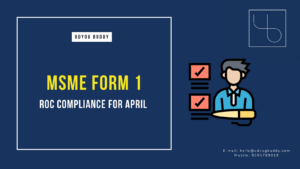Striking off the name of a company
Section 248 to 252 of the Companies Act, 2013 (‘Act’) provides the procedure of striking off company names by the ROC or voluntary by the company.
426+ Clients Served Globally



INTRODUCTION
Striking off the name of a company is an alternative mechanism for closing the operations of the company. The Registrar of Companies (‘ROC’) can issue a notice to strike off the company name from the Register of Companies for certain reasons. The company can also apply for the ROC to strike off its name from the Register of Companies.
Section 248 to 252 of the Companies Act, 2013 (‘Act’) provides the procedure of striking off company names by the ROC or voluntary by the company. Strike off of a company name means closing a defunct company in a faster manner. It is the simplest way to dissolve a company.
GROUNDS FOR STRIKING OFF OF THE COMPANY
- A company has failed to commence its business within one year of its incorporation;
- A company is not carrying on any business or operation for a period of two immediately preceding financial years and has not made any application within such period for obtaining the status of a dormant company under section 455
DORMANT COMPANY
The word dormant, in general terms, means inactive or inoperative. Similarly, a company is classified as dormant if it has been registered under the Companies Act for a future project or to hold an asset or intellectual property but isn’t pursuing any significant accounting transactions. To gain the classification though (which has its own benefits) the Company must file an application to the Registrar. The concept of dormancy was introduced to the corporate provisions in the Companies Act of 2013.
APPLICATION BY COMPANY FORREMOVING ITS NAME FROM REGISTER OF COMPANIES
E-Form STK-2 is required to be filed pursuant to Section 248(2) of the Companies Act, 2013 and rule 4, 5, 6 & 8 of the Companies (Removal of Names of Companies from the Register of Companies) Rules, 2016
The Form STK-2 can only be filed by an Active Company or by a dormant company, it cannot be filed by a Section 8 Company.
No application in Form No. STK-2 shall be filed by a company unless it has filed overdue returns in Form No. AOC-4 (Financial Statement) or AOC-4 XBRL, as the case may be, and Form No. MGT-7 (Annual Return), up to the end of the financial year in which the company ceased to carry its business operations.
PROCEDURE FOR VOLUNTARY STRIKING OFF OF COMPANY
- Holding of Board Meeting:
The passing of Board Resolutions has been mandated for major enactments in the corporate sphere.
- Closing of liabilities:
A company desirous of a strike-off must have closed off all its liabilities.
- Holding of General Meeting:
A general meeting of shareholders should be held by the company by passing a special resolution for striking off the name of the Company.
- Furnishing of Applications and documents required to be attached with E-form STK-2:
Companies on the pursuit of strike-off must file an application to the Registrar of Companies (ROC), accompanied by the following documents:
- Indemnity Bond duly notarized by all directors (in Form STK 3) to be given individually or collectively.
- A statement of liabilities comprising of all assets and liabilities of the companies (certified by a Chartered Accountant)made up to a day, not more than thirty days before the date of application.
- An affidavit in Form STK 4 (by all directors of the company).
- Certified True Copy of Special Resolution (duly signed by every director of the company).
- Bank Account Closure Certificate
- a statement regarding pending litigations, if any, involving the company.
- Copy of relevant order of delisting, if any, from the concerned stock exchange.
- No objection certificate from relevant regulatory department in case company is governed by such department.
PROCEDURE FOLLOWED BY ROC AFTER FILING OF E-FORM STK-2
Application filed by a company for striking off its name should be published in the Official Gazette for informing the general public. The ROC will strike off the company name from the Register of Companies upon the expiry of the specified time in the notice for striking off unless the company shows the contrary reason for the same within the mentioned time.
The ROC will publish the dissolution notice in the Official Gazette after striking off the company name in the Register of Companies. Upon publication of the notice in the Official Gazette, the company will stand dissolved.
Before passing an order of company dissolution and striking off the company name, the ROC will satisfy itself that sufficient provision is made for the payment or discharge of company liabilities, the realization of amounts due to the company and its obligations within a reasonable time.
The ROC will also obtain the necessary undertaking from the director, managing director or other persons in charge of the company management in this regard.
However, the company’s assets will be available for the discharge or payment of its obligations and liabilities even after the date of the order of removing the company name from the Register of Companies.
IMPLICATIONS OF DISSOLVEMENT
If a company confirms its dissolvement, it shall cease its operations as a company from the date of such dissolvement, and the Certificate of Incorporation issued to it by the ROC shall be deemed to have been canceled, except for the discharge of any existing liabilities or obligations
COMPANIES RESTRICTED FOR MAKING APPLICATION FOR STRIKE OFF
Companies are restricted on filing applications for strike-off, if at any time during the last three months, it has:
- The company has changed its name or relocated its registered office to another state.
- Made a disposal for the value of property or rights held by it (subject to conditions).
- Engaged in any other activity other than what is necessary or expedient for making an application under the concerned provision, and so and so forth.
- Filed an application to the Tribunal for the granting of Compromise or Arrangement, and a consensus for the same hasn’t yet been arrived at.
- Been wound up under Chapter XX, whether voluntarily, by the Tribunal or under the Insolvency and Bankruptcy Code (IBC), 2016.
FEES ASSOCIATED WITH E-FORM STK-2
E-form STK-2 has fees of INR 10,000/-
CONCLUSION
The Companies Act, 2013 (Act) provides for various modes by which a company can be dissolved such as striking off, winding up, amalgamation etc. The mode and manner of closing a company depends upon a number of factors such as commercial rationale of the members, financial position and business operations of the company, timelines and costs involved etc.
When a company is not carrying on any business, its operations have been shut down and there is no intention of reviving it in the future, then it should be prudent to file an application for strike off its name from the register of companies(“Register”) by following a simple procedure prescribed under chapter 18 (section 248 to 252) of the Act read with The Companies (Removal of Name of Companies from the Register of Companies) Rules, 2016.
Udyog Buddy has helped a number of clients by dispelling myths and helping them grow their businesses.
To avail of all the Company related services and get an Edge Over Your Competitors Call/Whatsapp +91 9301789019 or email at hello@udyogbuddy.com.
Add Your Heading Text Here
Lorem ipsum dolor sit amet, consectetur adipiscing elit. Ut elit tellus, luctus nec ullamcorper mattis, pulvinar dapibus leo.
Lorem ipsum dolor sit amet, consectetur adipiscing elit. Ut elit tellus, luctus nec ullamcorper mattis, pulvinar dapibus leo.Lorem ipsum dolor sit amet, consectetur adipiscing elit. Ut elit tellus, luctus nec ullamcorper mattis, pulvinar dapibus leo.





